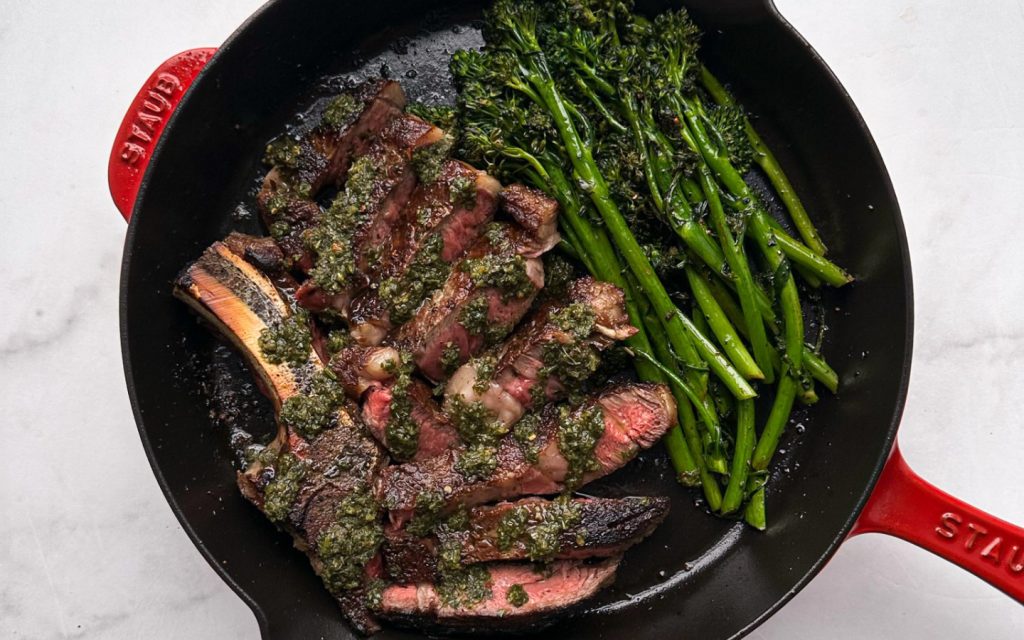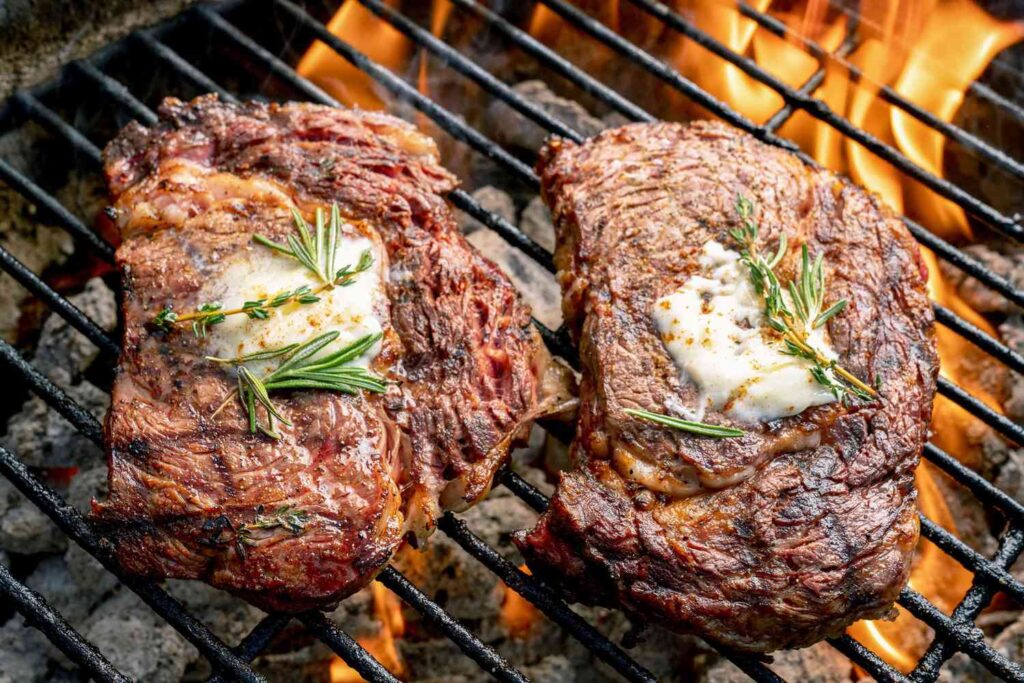
How to Cook the Perfect Steak : Delicious Recipes
Here we will guide you everything you need to know about how to cook the perfect steak? Cooking the perfect steak involves selecting a quality cut, seasoning it well, and using the right cooking techniques. Here’s a step-by-step guide to achieving a perfectly cooked steak:
Key Characteristics of a Perfect Steak:
High-Quality Meat
Cut: Popular cuts for a perfect steak include ribeye, strip steak, tenderloin (filet mignon), and porterhouse. Each has its unique flavor and texture.
Marbling: The presence of intramuscular fat (marbling) enhances the flavor and juiciness of the steak. Look for well-marbled cuts.
Thickness: A steak that is at least 1 to 1.5 inches thick will cook more evenly and retain juiciness.
Proper Seasoning
Simplicity: A perfect steak is often seasoned simply with kosher salt and freshly ground black pepper to enhance its natural flavors.
Optional Enhancements: Adding garlic powder, onion powder, or smoked paprika can provide additional layers of flavor. Fresh herbs like rosemary and thyme, along with butter, can be used during cooking for a richer taste.
Precise Cooking
Room Temperature: Allow the steak to come to room temperature before cooking for even heat distribution.
Searing: Searing the steak at high heat creates a flavorful crust. This can be achieved using a cast-iron skillet or a grill.
Learn More Recipe: How to Cook a Roast Chicken
Internal Temperature: Use a meat thermometer to achieve the desired doneness:
Rare: 120-125°F (49-52°C)
Medium: 130-135°F (54-57°C)
Rare: 140-145°F (60-63°C)
Well: 150-155°F (66-68°C)
Well Done: 160°F (71°C) and above
Resting
Essential Step: Let the steak rest for 5-10 minutes after cooking. This allows the juices to redistribute throughout the meat, resulting in a juicier steak.
Tent with Foil: Lightly tent the steak with aluminum foil while resting to keep it warm.
Finishing Touches
Butter Basting: In the last minute of cooking, add a pat of butter, garlic, and herbs to the pan and spoon the melted butter over the steak.
Slicing: Always slice the steak against the grain to maximize tenderness.
Cooking Methods

Pan-Seared
Preheat Skillet: Heat a cast-iron skillet over high heat until very hot.
Add Oil: Use a high smoke point oil like canola or grapeseed.
Sear and Flip: Sear the steak for 2-3 minutes on each side.
Butter Basting: Add butter and aromatics, basting the steak in the last minute.
Grilled

Preheat Grill: Heat the grill to high (450-500°F or 230-260°C).
Oil Grates: Prevent sticking by brushing the grates with oil.
Grill: Cook the steak for 4-5 minutes per side for medium-rare.
Rest: Let it rest before serving.
Ingredients
Steak: Choose a high-quality cut like ribeye, strip steak, tenderloin (filet mignon), or porterhouse.
Salt: Kosher salt is preferred for its coarse texture.
Pepper: Freshly ground black pepper.
Oil: A high smoke point oil like canola, grapeseed, or avocado oil.
Butter: Unsalted butter for basting.
Garlic: A few cloves, smashed.
Herbs: Fresh rosemary and thyme.
Optional Ingredients
Additional Seasonings: Garlic powder, onion powder, or smoked paprika for extra flavor.
Finishing Salt: Flaky sea salt like Maldon for a finishing touch.
Instructions
Preparation
Thaw the Steak: If frozen, thaw the steak in the refrigerator for 24 hours.
Bring to Room Temperature: Take the steak out of the fridge 30 minutes before cooking.
Learn More Recipe: How To Cook Steak
Seasoning
Season Generously: Pat the steak dry with paper towels. Season both sides generously with kosher salt and freshly ground black pepper. If using, add a sprinkle of garlic powder, onion powder, or smoked paprika.
Preheat the Skillet
High Heat: Preheat a cast-iron skillet over high heat until it is very hot. This can take about 5 minutes.
Searing the Steak
Add Oil: Add a tablespoon of high smoke point oil to the skillet and swirl to coat.
Sear: Place the steak in the skillet and sear for 2-3 minutes without moving it. Flip the steak and sear the other side for another 2-3 minutes.
Butter Basting
Add Butter and Aromatics: In the last minute of cooking, add a few tablespoons of butter, smashed garlic cloves, and fresh herbs (rosemary and thyme) to the skillet.
Baste the Steak: Tilt the skillet and use a spoon to baste the steak with the melted butter for about a minute.
Check Doneness
Internal Temperature: Use a meat thermometer to check the internal temperature:
Rare: 120-125°F (49-52°C)
Medium: 130-135°F (54-57°C)
Rare: 140-145°F (60-63°C)
Well: 150-155°F (66-68°C)
Well Done: 160°F (71°C) and above
Resting
Transfer and Rest: Transfer the steak to a cutting board and loosely tent with aluminum foil. Let it rest for 5-10 minutes to allow the juices to redistribute.
Serving
Slice and Serve: Slice the steak against the grain to maximize tenderness. Sprinkle with flaky sea salt for a finishing touch if desired.
Learn More Recipe: How to Cook Lamb
FAQ:
What cut of steak should I use for the perfect steak?
Popular Cuts: Ribeye, strip steak, tenderloin (filet mignon), and porterhouse are all excellent choices.
Why These Cuts?: These cuts are known for their tenderness, flavor, and good marbling, which enhances juiciness and taste.
How do I choose a high-quality steak?
Marbling: Look for steaks with good marbling (intramuscular fat), as this contributes to flavor and juiciness.
Color and Freshness: Fresh steaks should be bright red and have a firm texture.
Thickness: Choose steaks that are at least 1 to 1.5 inches thick for even cooking.
How should I season my steak?
Basic Seasoning: Generously season with kosher salt and freshly ground black pepper.
Optional Seasonings: Add garlic powder, onion powder, or smoked paprika for extra flavor.
Herbs and Butter: Fresh rosemary, thyme, and butter can be used for basting during cooking.
Do I need to marinate my steak?
Optional: Marinating can add additional flavors but is not necessary if you have a high-quality cut.
Simple Marinade: Olive oil, garlic, herbs, and a splash of soy sauce or Worcestershire sauce can enhance flavor if desired.
How do I cook my steak to the desired doneness?
Internal Temperatures:
Rare: 120-125°F (49-52°C)
Medium: 130-135°F (54-57°C)
Rare: 140-145°F (60-63°C)
Well: 150-155°F (66-68°C)
Well Done: 160°F (71°C) and above
Use a Meat Thermometer: This ensures accuracy in achieving your desired doneness.
Should I let my steak come to room temperature before cooking?
Yes: Allowing the steak to come to room temperature (about 30 minutes out of the fridge) ensures even cooking
How should I cook my steak: pan-searing or grilling?
Pan-Searing: Ideal for achieving a good crust with the addition of butter basting.
Grilling: Great for adding a smoky flavor and achieving grill marks.
Combination: Searing in a pan and finishing in the oven can also be effective.
What oil should I use for cooking steak?
High Smoke Point Oils: Canola oil, grapeseed oil, or avocado oil are best to prevent burning at high temperatures.
How long should I let my steak rest after cooking?
Resting Time: Let the steak rest for 5-10 minutes to allow the juices to redistribute, ensuring a juicy steak.
Why is my steak tough?
Overcooking: Cooking past medium can result in a tougher texture.
Improper Slicing: Always slice against the grain to maximize tenderness.
Quality of Meat: Lower quality cuts or those with less marbling can be tougher.
Can I use a non-stick pan to cook my steak?
Not Recommended: A cast-iron skillet or stainless steel pan is preferred for achieving a good sear and crust.
What should I do if my steak is undercooked?
Return to Heat: You can return it to the skillet or grill for additional time, checking frequently to avoid overcooking.
Oven Finish: For thicker steaks, sear in the pan and finish cooking in a preheated oven at 400°F (200°C) until the desired doneness is reached.
Learn More Recipe: How to Cook a Spiral Ham
[…] Learn More Recipe: How to Cook the Perfect Steak […]